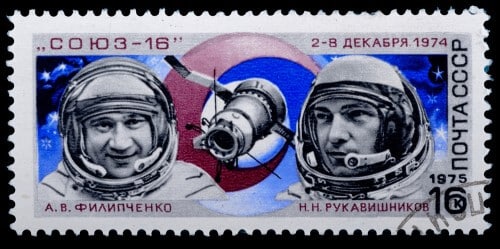On December 21, 1974, Soyuz 16 was launched with the astronauts Anatoly Filipchenko, the flight commander, and Nikolai Rokbyshnikov, the flight engineer.

We already wrote about the Apollo Soyuz flight in July 2013
On December 21, 1974, Soyuz 16 was launched with the astronauts Anatoly Filipchenko, the flight commander, and Nikolai Rokbyshnikov, the flight engineer.
The goals of the flight were:
A. To make a general preparation and rehearsal for the joint space flight with the ASTP project Apollo spacecraft. Soyuz 16 is identical in all respects to the spacecraft planned for ASTP. The pilot must check the spacecraft's systems. The flight path is the same as the ASTP path and the astronauts use an "imitation ring" to perform the attachment process. The ring allows the Soyuz some of the adhesion maneuvers. In the spacecraft there is a model of the Apollo spacecraft. The atmospheric pressure is the same as the pressure designed for Soyuz and ASTP. The purpose of the flight is to reach 100% of the ASTP project.
According to Filipchenko's statement, there is a possible connection between the spacecraft and the manned space flight center in Houston, United States. Only an hour after the launch of Soyuz 16, the space agency was informed about the launch. Nine American ground stations monitored the flight of Soyuz 16. Telephone conversations were also held between officials of the two countries about the course of the flight.
B. to examine possibilities of rescue in space.
third. To make observations over different areas of the Soviet Union and to take pictures for the purpose of collecting information for the solution of economic questions.
In his announcement before the flight, Filipchenko said that the flight would last several days. The Soyuz 16 has a radar and communication system and a new system to weaken the navigation engines for safety reasons during docking.
December 2 - immediately after it was launched, the astronauts began their work. At the end of the work they fell asleep for 8 hours. The flight path is 177-223 km and the inclination angle is 56 degrees. Upon entering the track, the imitation ring was deployed.
December 3 - After sleeping, the astronauts resumed their work. They performed medical, biological and experiments in the system of existence. The biological experiments that will be carried out in the ASTP project are reflected in the growth of micro-organisms under weightless conditions. The connection experiments with the imitation ring. The ring is attached to the spacecraft with a force equal to the mass of the Apollo spacecraft. A television broadcast was also held.
December 4 - The astronauts continue experiments in preparation for ASTP. The height of the route was changed to 225 km. Mainly, this day is dedicated to biological and medical experiments.
December 5 - The astronauts tested the function of the attachment system, the imitation ring and their auxiliary facilities. Biological and medical experiments were also conducted. The astronauts successfully completed several experiments and half of the flight was completed.
December 6 - The astronauts completed all the preparations for the ASTP operation. They used the imitation ring, tested other instruments related to the operation and made a series of photographs of the celestial bodies in preparation for the artificial solar eclipse that will be performed at ASTP. At the end of the experiments preparations for landing began. The astronauts packed equipment and tested the landing systems.
December 7 - Continue preparations for the landing and return the atmospheric pressure in the spacecraft to the normal pressure existing at sea level.
December 8 - After a stay of about 6 days in space (5 days, 22 hours, 36 minutes) Soyuz landed, 300 km north of Dzhazkazan. The health of the astronauts was excellent. A total of 20 adhesion maneuvers were conducted with the imitation ring.
